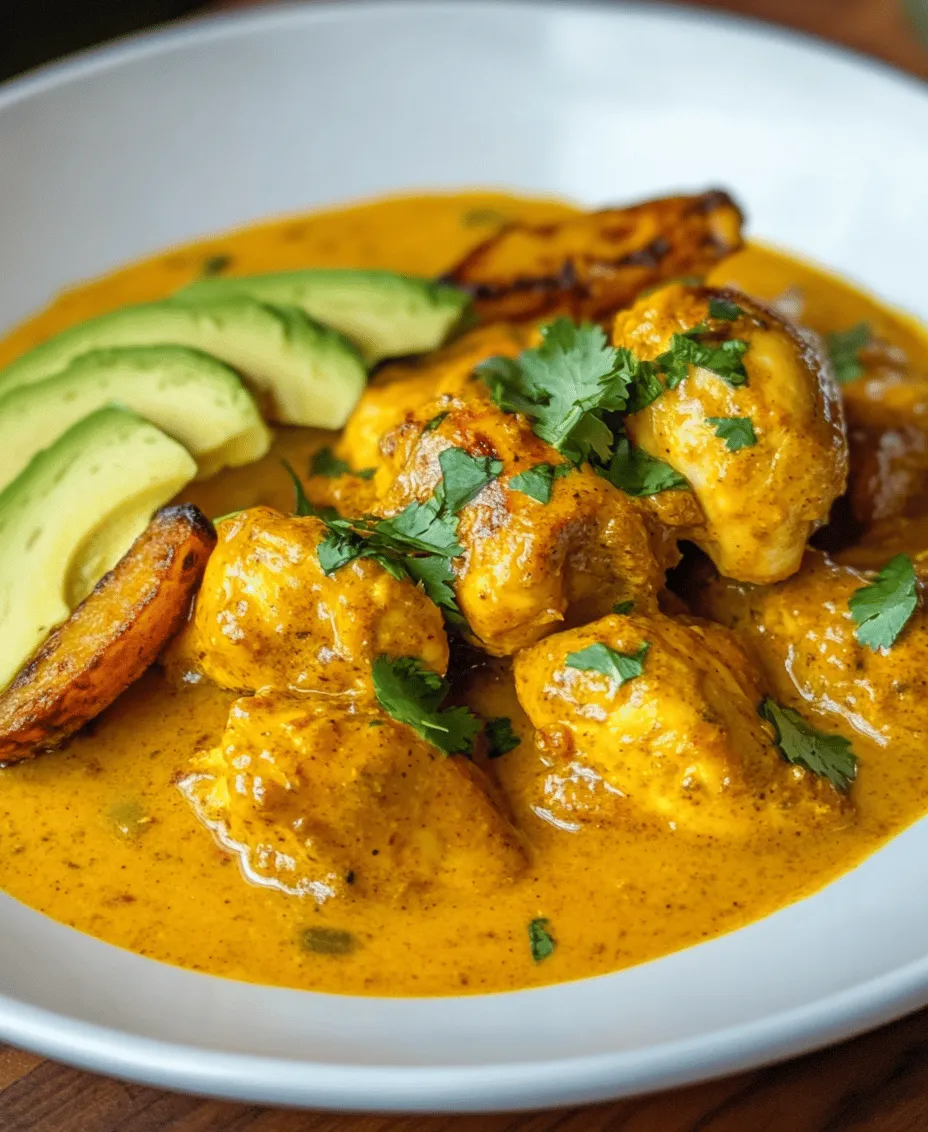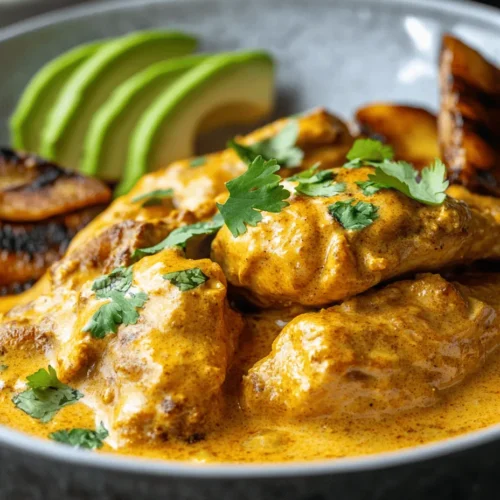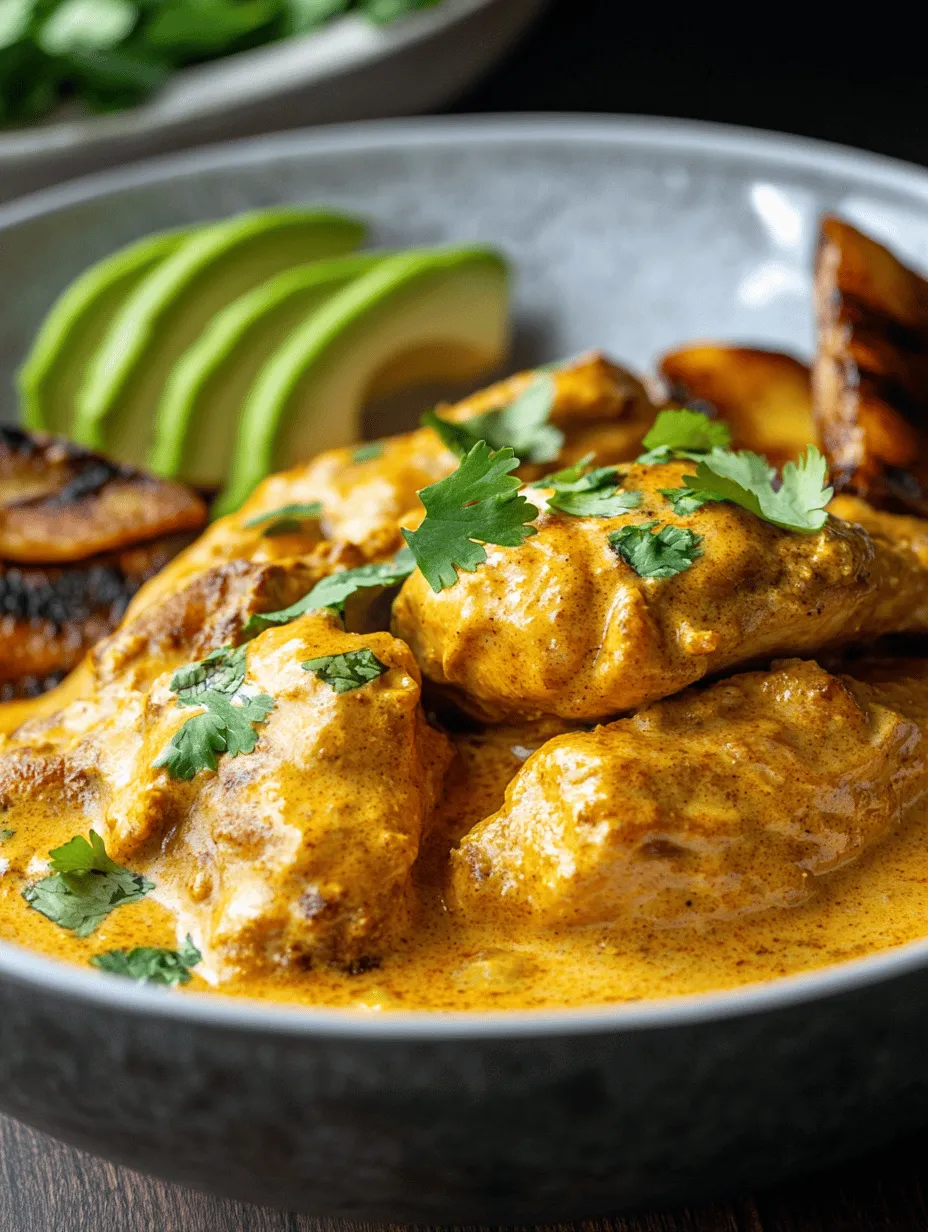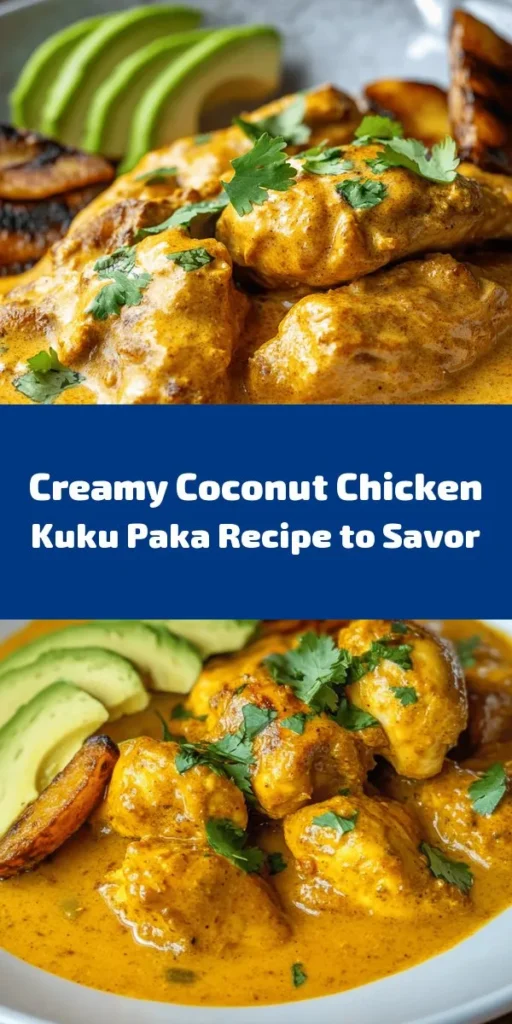Introduction
Kuku Paka is a beloved traditional dish hailing from East Africa, particularly popular in coastal regions like Kenya and Tanzania. This delicious dish showcases a unique blend of flavors that captures the essence of the region’s culinary diversity. The name “Kuku Paka” translates to “chicken in coconut,” and it is a perfect descriptor for this creamy, aromatic chicken curry that tantalizes the taste buds with every bite.
At the heart of Kuku Paka is its signature ingredient: coconut milk. This creamy component not only enriches the dish but also harmonizes beautifully with a variety of spices, creating a delightful medley of flavors. The use of aromatic spices such as curry powder, cumin, and coriander enhances the dish’s depth, making it a comforting and satisfying meal option. Whether served at family gatherings or enjoyed as a weeknight dinner, Kuku Paka brings people together and celebrates the rich culinary traditions of East Africa.
Understanding Kuku Paka
Historical Context
Kuku Paka’s origins can be traced back to the Swahili Coast of East Africa, where it has evolved over centuries, incorporating influences from various cultures. The dish reflects the melting pot of culinary traditions found in the region, particularly the influence of Indian cooking techniques and flavors. The arrival of Indian traders and migrants along the Swahili Coast introduced new spices and cooking methods, which have since been integrated into the local cuisine.
As a result, Kuku Paka is not just a dish; it is a cultural symbol that showcases the interconnectedness of different culinary practices. The marriage of coconut milk with Indian spices is a testament to the region’s historical trade routes, where ingredients and cooking styles blended to create this delightful recipe.
Flavor Profile
The flavor profile of Kuku Paka is a harmonious balance between the creaminess of coconut milk and the vibrant spices that elevate the dish. The creamy texture of the coconut milk envelops the chicken, imparting a luscious quality that makes each bite a comforting experience. The spices—ranging from fragrant curry powder to earthy cumin and coriander—contribute to a complex flavor that is both aromatic and savory.
The result is a dish that is rich and satisfying, perfect for any occasion. The interplay of flavors creates a delightful culinary experience that captivates both the palate and the senses. With each spoonful, Kuku Paka offers a taste of East Africa’s rich heritage and its culinary artistry.
Ingredients Breakdown
Chicken Selection
When preparing Kuku Paka, selecting the right chicken is crucial for achieving the best flavor and moisture. Bone-in chicken pieces, such as thighs or drumsticks, are preferred as they tend to be juicier and more flavorful than boneless cuts. The bones contribute to the overall richness of the dish, allowing the chicken to absorb the aromatic spices and creamy coconut milk during cooking.
For those with different dietary preferences, there are alternatives to traditional chicken. Chicken thighs are a fantastic option due to their tenderness and ability to remain moist throughout the cooking process. Additionally, for a plant-based variation, you can substitute chicken with firm tofu or chickpeas, which will soak up the flavors of the sauce beautifully.
Coconut Milk
Coconut milk is the star ingredient in Kuku Paka, serving as the base for its creamy sauce. It provides a velvety texture that complements the spices while enhancing the dish’s overall richness. When choosing coconut milk, opt for full-fat varieties for the best creaminess, as they deliver a luxurious mouthfeel that light coconut milk cannot match. Brands like Thai Kitchen or Aroy-D are popular choices, known for their quality and flavor.
Incorporating coconut milk into your cooking not only adds flavor but also brings numerous health benefits. It is rich in healthy fats, particularly medium-chain triglycerides (MCTs), which can aid in weight management and provide quick energy. Additionally, coconut milk is dairy-free, making it an excellent alternative for those with lactose intolerance or dairy allergies.
Aromatics and Spices
The magic of Kuku Paka lies in its aromatic ingredients, which include onion, garlic, and ginger. Each of these components plays a vital role in building the dish’s flavor profile. Onions provide sweetness and depth, while garlic and ginger add a fragrant warmth that enhances the overall taste. When sautéed, these ingredients release their natural oils, infusing the dish with a robust aroma that sets the stage for the spices to shine.
The spices used in Kuku Paka are essential for creating its distinctive flavor. Curry powder, with its blend of spices, adds warmth and complexity, while coriander and cumin contribute earthy notes that balance the richness of the coconut milk. Turmeric, known for its vibrant color and health benefits, not only enhances the dish’s appearance but also adds a subtle warmth and depth of flavor. These spices are not only delicious but also packed with antioxidants and anti-inflammatory properties, making Kuku Paka a wholesome choice for any meal.
Additional Ingredients
To elevate the flavors further, a splash of lime juice is often added to Kuku Paka. This tangy ingredient helps to brighten the dish, cutting through the richness of the coconut milk and adding a refreshing note. The acidity from lime juice balances the sweetness of the coconut and enhances the overall flavor profile.
For those looking to add more texture and taste to their Kuku Paka, consider incorporating optional ingredients such as sliced avocado or fried plantains. These additions not only provide contrasting textures but also complement the dish’s creamy and savory elements, creating a more well-rounded meal.
Step-by-Step Cooking Instructions
Marinating the Chicken
The first step in creating the perfect Kuku Paka is marinating the chicken. Start by combining your chosen chicken pieces with a blend of spices, salt, and a splash of lime juice. This marination process allows the flavors to penetrate the meat, ensuring that every bite is infused with the aromatic spices. Allow the chicken to marinate for at least 30 minutes, but for optimal results, consider letting it sit for a few hours or even overnight in the refrigerator. This step not only enhances the flavor but also helps to tenderize the chicken, resulting in a succulent dish.
Once the chicken is marinated, you can begin the cooking process. Prepare your cooking pot by heating a bit of oil over medium heat. As the oil shimmers, add chopped onions, sautéing them until they turn translucent and fragrant. This step is crucial, as it forms the flavor base of Kuku Paka. Once the onions are softened, introduce minced garlic and ginger, allowing them to cook for an additional minute until aromatic.
Next, add the marinated chicken pieces to the pot, browning them on all sides. This step locks in the flavors and creates a rich foundation for the dish. After the chicken is browned, pour in the coconut milk, stirring to combine all the ingredients. The creamy coconut milk will envelop the chicken, creating a luxurious sauce that will simmer and develop flavors as it cooks.
Continue Cooking
Once the coconut milk is added, it’s important to bring the mixture to a gentle simmer. This allows the chicken to cook through while the flavors meld together beautifully. Reduce the heat to low and cover the pot, letting it simmer for about 25-30 minutes. During this time, the chicken will become tender and soak up the aromatic spices from the sauce.
As the Kuku Paka cooks, be sure to stir occasionally to prevent any sticking and to ensure an even distribution of flavors. You can also taste the sauce and adjust the seasoning as needed, adding more salt or lime juice to achieve the desired balance of flavors.
By the end of the simmering process, you’ll have a creamy, aromatic Kuku Paka that is ready to be served over a bed of fluffy rice or with warm naan bread, allowing you to soak up every bit of the delicious sauce.
As you prepare to enjoy this delightful dish, remember that Kuku Paka is not just a meal; it’s an experience that embodies the rich culinary heritage of East Africa. The labor of love put into marinating and cooking the chicken culminates in a dish that is both comforting and celebratory, perfect for sharing with family and friends.

Marination is a crucial step in making Kuku Paka, as it infuses the chicken with flavor and enhances its tenderness. The chicken absorbs the spices and other ingredients during marination, leading to a more flavorful and succulent final dish. For optimal results, allow the chicken to marinate for at least 1 hour at room temperature or, even better, overnight in the refrigerator. This longer marination time lets the spices penetrate the meat deeply, ensuring that every bite is packed with flavor.
Sautéing Aromatics
The next step involves sautéing aromatics, which form the flavor base of Kuku Paka. Begin by heating a generous amount of oil in a large skillet or pot over medium heat. Once the oil is hot, add finely chopped onions. Sauté them for about 5-7 minutes until they become translucent and start to caramelize, releasing a sweet aroma.
Following the onions, add minced garlic and grated ginger. The combination of these three aromatics – onions, garlic, and ginger – is essential in creating the signature flavor profile of Kuku Paka. Sauté them together for another 2-3 minutes, stirring frequently to prevent burning. The fragrant aroma released during this process is crucial in developing the dish’s depth and complexity. Properly sautéed aromatics create a savory foundation that elevates the overall taste of the dish.
Browning the Chicken
Once the aromatics are ready, it’s time to brown the marinated chicken pieces. Carefully add the chicken to the skillet, making sure not to overcrowd the pan. Browning the chicken is key to achieving a golden crust, which adds both texture and flavor. For the best results, let the chicken sear undisturbed for about 5-6 minutes on one side before flipping it. You should see a beautiful golden-brown color developing on the surface.
This browning process not only enhances the visual appeal of the dish but also contributes to the overall flavor through the Maillard reaction, which occurs when proteins and sugars in the chicken are heated. Once the chicken is browned on all sides, remove it from the skillet and set it aside while you prepare the sauce.
Adding Spices and Tomato
Now, it’s time to add the spices and tomato, which will create the rich sauce that Kuku Paka is known for. In the same skillet with the remaining oil and drippings, add a mix of spices, including turmeric, cumin, coriander, and chili powder. Toast these spices for about 1-2 minutes until they become fragrant. Toasting spices releases their essential oils, enhancing their flavors significantly.
Next, incorporate blended tomatoes into the skillet. Using fresh tomatoes or canned tomato puree is acceptable, but blending them ensures a smooth consistency that integrates well with the spices. Cook the mixture for 5-7 minutes, allowing the tomatoes to reduce and thicken slightly. This step is vital for achieving a cohesive sauce that clings beautifully to the chicken.
Incorporating Coconut Milk
With the spice and tomato mixture prepared, it’s time to add the coconut milk, a key ingredient that gives Kuku Paka its signature creaminess. Pour in the coconut milk gradually, stirring continuously to ensure even distribution throughout the sauce. This step is crucial; if the coconut milk is added too quickly or without stirring, it may curdle or separate, compromising the dish’s texture.
Once the coconut milk is fully incorporated, return the browned chicken to the skillet. Simmer the chicken in the sauce for about 20 minutes, allowing it to cook through and absorb the rich flavors. Adjust the heat to maintain a gentle simmer, which helps meld the flavors together without overcooking the chicken. You want a sauce that is creamy yet not too thick, so if necessary, add a splash of water or broth to reach your desired consistency.
Final Adjustments and Serving Suggestions
After simmering, taste the sauce and adjust the seasoning as needed. Depending on your preference, you may want to add more salt, pepper, or a dash of lime juice for acidity. Final adjustments can elevate the entire dish, allowing it to cater to your taste buds.
When it comes to serving Kuku Paka, the options are abundant. Traditionally, it pairs wonderfully with steamed rice or flatbreads like chapati or naan. The creamy sauce is perfect for dipping or soaking up with bread. Consider garnishing the dish with freshly chopped cilantro or parsley for an added burst of freshness. You can also serve it alongside a simple cucumber salad or sautéed greens to balance the richness of the chicken.
Nutritional Information
Kuku Paka is not only delicious but also offers various nutritional benefits. The primary ingredients, such as chicken and coconut milk, contribute significantly to this dish’s nutritional profile. A typical serving of Kuku Paka contains approximately 420 calories, with macronutrients including about 25 grams of protein, 30 grams of fat (largely from coconut milk), and 8 grams of carbohydrates.
Chicken is an excellent source of lean protein, essential for muscle growth and repair. Coconut milk, while higher in fat, contains medium-chain triglycerides (MCTs), which may provide quick energy and are believed to have various health benefits, including improved metabolism and heart health. The spices used also bring their benefits; for instance, turmeric is known for its anti-inflammatory properties.
Cultural Significance of Kuku Paka
Kuku Paka holds a special place in East African cuisine, particularly in coastal regions like Kenya and Tanzania. It is often prepared during celebrations, family gatherings, and special occasions, symbolizing warmth and hospitality. The dish reflects a blend of culinary influences, including Indian and Swahili flavors, showcasing the rich tapestry of cultural interactions in the region.
Personal anecdotes surrounding Kuku Paka often highlight its role in bringing families together. Many people recall the comforting aroma wafting through their homes while preparing this dish, creating a sense of nostalgia and community. Whether it’s enjoyed at a festive gathering or a simple family dinner, Kuku Paka embodies the spirit of togetherness and celebration.
Conclusion
Kuku Paka is a delightful dish that combines tender chicken, aromatic spices, and creamy coconut milk, creating a comforting meal that can bring people together. Its simplicity in preparation, paired with its rich flavors, makes it an ideal choice for both busy weeknights and festive gatherings.
Whether you’re a seasoned cook or a beginner, this dish is approachable and adaptable, allowing you to personalize it to your taste. We encourage you to try making Kuku Paka at home; it’s a wonderful way to explore East African cuisine and share a delicious experience with those you love. With its versatility, Kuku Paka can easily be modified to suit different dietary preferences, making it a dish that everyone can enjoy. Embrace the flavors, the culture, and the joy of cooking this creamy coconut chicken delight!



